
The Ultimate Guide to Dock Piling Materials
Piling is the foundation of any dock—and choosing the right material is key to building a long-lasting, sturdy dock.
In addition to wind and rain, piles also have to withstand being submerged in water and being targeted by marine borers and roosting birds. In this guide, the experts here at Decks & Docks cover what you need to know about each type of dock piling material and protection accessory.
Dock Piling Materials
When choosing a dock piling material, you have two options: natural or synthetic. Each has different pros and cons depending on the environment you live in and the level of upkeep you’re able to dedicate to your dock.
Natural Marine Timbers
Natural marine timber is a classic choice for docks, but not just any wood can be used for piles. Because they’re constantly submerged in water, piles need to either be pressure treated or made of a naturally water-resistant hardwood.
- Treated softwood. Treated wood piling is a true all-rounder. While treated wood isn’t invulnerable to decay and marine pests, its affordability and customizability make it a popular option for a reason. The most common species is pine. Our wood features the maximum treatment (2.5 CCA) for saltwater submersion.
- Hardwood. Hardwoods, like our Greenheart piling, are naturally tough against water and rot. They don’t require pressure treatment like softwoods. Some hardwoods are literally hard—too hard for your average DIY toolkit. Depending on the species of wood, these piles may need to be pre-cut and pre-drilled at the lumber yard. Common species include Greenheart, redwood, fir, and cedar.
Understanding “Marine Grade” Pressure Treatment for Lumber
We mentioned that pressure treatment is important for piles, but what does that mean?
Before some species of timber can be exposed to water and other natural elements, they need to be pressure treated. When treated properly and maintained, natural wood piling can last decades.
Pressure treatment is a process that fortifies natural lumber against mold, rot, and pest infestations. Lumber is put in a pressurized, vacuum-sealed chamber and then exposed to a chemical treatment that penetrates deep into the fibers of the wood. The most common chemical used is copper, which gives pressure-treated lumber its famous green tint.
Not all pressure treatments are the same. For example, some are only cleared for freshwater use—and not all treatments are cleared for contact with the ground. Before you buy wood, you need to make sure the treatment is suited for your home waters.
Want to learn more? Read our guide to understanding treated lumber classifications.
Synthetic Piling
Man-made materials tend to require significantly less maintenance than natural wood. With synthetic piles, you won’t need to worry about rot or pests penetrating natural fibers.
However, synthetic piles tend to have higher upfront costs and specialized installation needs. They’re often suited for commercial marinas and docks where easy upkeep and durability are the priority.
- Fiberglass. Using fiberglass composite materials for dock piling is a modern innovation. Engineered to never rot, rust, or crumble, fiberglass pilings are ideal for low-maintenance docks. Fiberglass piles are also straight as a die and identical to each other, which eliminates some of the hassle of natural wood. Our preferred brand is Fortress, which makes piles that are stronger and more attractive-looking than competitors.
- Concrete. Concrete may not be as stylish as wood, but it is naturally resistant to decay and often reinforced with steel to improve its tensile strength. When fully cured, concrete pilings are safe to use in both freshwater and saltwater. However, concrete isn’t always the best choice for residential docks because of its appearance and difficult installation.
How do you choose the right material?
There are a few things to ask yourself when selecting a piling material:
- Is this dock being built in fresh, brackish, or saltwater?
- What’s the weather situation like? Does this area see hurricanes?
- Does the water freeze over in the winter?
- Is there going to be a lot of boat traffic at this dock?
- Is this dock for a private residence or a commercial marina?
For smaller private docks, natural lumber or fiberglass is as good-looking as it is long-lasting. For busy marinas, fiberglass or concrete may require fewer repairs and be less affected by accidental boat damage.
If you’re still not sure what’s right for you, ask a dock expert.
Dock Piling Accessories
Piling accessories can add years to your dock’s life. We carry a selection of piling protection accessories to help you cut back on maintenance and repairs.
- Piling sleeves. Sleeves are heat-shrunk onto the piles before they’re ever placed in water. This creates a waterproof, UV-proof layer that also resists marine pests.
- Piling wraps. While sleeves must be installed before the dock is built, wraps can be placed after the piles are already in the water. Wraps provide a lot of the same protection as sleeves but aren’t as water-tight.
- Piling caps. Piling caps pretty much do what you’d expect: they keep the top of the dock pilings protected from water, UV rays, and birds. They help to limit damage at the exposed, cut end of the dock piling. Pointed caps also discourage birds from roosting. (We also have lighting options for your piling caps!)
Get Help Choosing the Right Piling Option
There’s a lot to consider when picking out piling materials. Whether you’re a homeowner building a backyard dock or a contractor making a plan for a commercial marina, we can help.
Contact the Decks & Docks team today to get answers to all your questions or learn more about your options. You can also visit a lumber yard near you to see things for yourself.
- About the Author
- Latest Posts